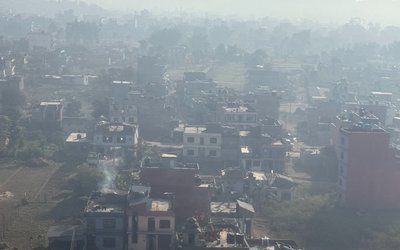While at school I remember having studied Oliver Goldsmith’s ‘The Deserted Village’ which depicted the onset of the industrial revolution in England. The lines about the common folk being awed by the village school teacher went like this:
And still they gazed and still the wonder grew
That one small head could carry all he knew.
Because of the country’s inability to provide employment our young and able bodied citizens are forced to look for unskilled jobs in the Gulf or Malaysia. As a result of this, our villages in Nepal are also deserted.
The village green in the England of those times where people met was also a place where cricket was usually played. Another practice in the Western or developed world is that many noted and successful authors of the past and even present ones tend to live in villages for the quiet environment which they feel is necessary for creative writing. Beside writers others also have a yearning to live in the countryside rather than in the towns. No wonder then that there are reputed places, such as Greenwich Village in the New York area which has been an artist’s haven for ages. Some academic institutions also refer to the campus as University Village. Then once in every four years, one reads in the papers about the specially constructed Olympic village for the sportsmen taking part. Furthermore, in this day of rapid communication, many persons in different parts of the world feel that their habitat has become so much more reachable that it can now be referred to simply as the Global Village!
According to the UN’s Department of Economic and Social Affairs the current world urbanisation of 54% in 2014 will increase to 66% by the year 2050. The present estimate in 2014 for Nepal is that 17% of our population is currently living in towns. This figure will be much higher by 2050 because of the trend towards urbanisation.
What then is the present state in Nepal? In 1947, when Padma Shumsher was prime minister there were four Nagarpalikas - three in Kathmandu Valley i.e. Kathmandu, Bhadgaon, Patan and one outside in Biratnagar. Perhaps, because of the existing situation, the Nepal Medical Council Act, when legislated was first made applicable in the three towns of the valley and only much later in Biratnagar.
One remembers that during the days of Panchayat rule there were Regions, Anchals, Nagar Panchayats and Village Development Councils (VDC). All in all, there were about 4,000 VDCs. After the passing of the Interim Constitution the government was expected to provide free primary health services to the economically deprived or poor in the existing 58 municipalities or Nagarpalikas in the country. The Ministry of Health & Population (MoH&P) and the Local Development Councils were responsible for this. In May 2014 the government announced the formation of 72 new municipalities and a further 61 in December of the same year, making a total of 191 municipalities. The breakdown of this is 21, 19, 36, 67 and 48 in the Far Western, Mid-Western, Western, Central and Eastern Regions respective. One criterion for this selection and designation. to be considered as a town, was that the site concerned had to have a population of 20,000 in the Terai or 10,000 in the hills. What about other facilities such as water, sanitation, transport facilities and electric supplies? Will there be eco-friendly facilities with open spaces and greenery where the inhabitants can spend their leisure? In olden times we had chautaras, tundikhels and gaucharans, but most of these have been encroached upon. Will the new building codes be followed or will a concrete jungle result. A recent report from Badimalika Municipality highlights non-compliance of the requisites necessary.
The whole country is now in a quandary. How should the country be divided or sub-divided? Should it be on the basis of ethnicity or what? Should the existing Zones, Districts, Nagarpalikas, and VDC be kept as such or should there be major or minor adjustments? Should demarcations be on a North to South basis comprising of mountains, hills and plains or should the divisions be on the basis of valleys and the rivers dissecting through? Alternatively, should the question of viability be of importance in making such states or administrative units? Or can the problem be solved by just having three provinces, going from East to West labelled simply mountains province, hills province and plains with the administrative costs being provided by the government in the capital!
With all these thoughts one wonders what the present government is trying to do by announcing the setting up more towns. What surprises is that there are no disputes regarding the naming of these towns. At the rate that municipalities are announced, one is forced to imagine something more sinister afoot. Will there be no VDCs but only towns in Nepal? Whilst taxes from VDC are minimal is it all a ploy to take in more money in the form charges for services that are non-existent? The supply of water, electricity, sanitation and the disposal of garbage exist on paper only and are not likely to be provided in the near future? Is this all a hoax to fool the gullible public, take them for a ride and demand more money? Is the situation going to get worse if the country is divided on the basis of ethnicity? What worries many is that sections of districts and towns will have to be re-demarcated - entailing further expenditure once again. The government and the officialdom will be happy to handle tons of finance in the process. Is our country heading towards more turmoil with all the political leaders of all parties delighted in anticipation that the heyday is at hand. Our two adjacent neighbours are surely watching developments with interest.

Hemang Dixit
The author writes fiction under the name of Mani Dixit. Website: www.hdixit.org.np. Twitter: @manidixithd
- Top Heavy
- Sep 20, 2023
- Most Able?
- Sep 04, 2023
- Changing Times
- Aug 21, 2023
- Nepali Shenanigans
- Aug 03, 2023
- Budget Naataks
- Jun 29, 2023














